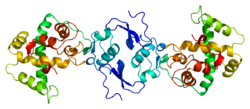Osteonectin
| Osteonectin | ||
|---|---|---|

|
||
| Ribbon model of a shortened osteonectin trimer (amino acids 71-303), according to PDB 1BMO | ||
| Properties of human protein | ||
| Mass / length primary structure | 286 amino acids | |
| Cofactor | Ca 2+ | |
| Identifier | ||
| Gene names | SPARC BM-40; ON | |
| External IDs | ||
| Occurrence | ||
| Parent taxon | multicellular animals | |
| Orthologue | ||
| human | House mouse | |
| Entrez | 6678 | 20692 |
| Ensemble | ENSG00000113140 | ENSMUSG00000018593 |
| UniProt | P09486 | P07214 |
| Refseq (mRNA) | NM_001309443 | NM_001290817 |
| Refseq (protein) | NP_001296372 | NP_001277746 |
| Gene locus | Chr 5: 151.66 - 151.69 Mb | Chr 11: 55.39 - 55.42 Mb |
| PubMed search | 6678 |
20692
|
Osteonectin (also known as Secreted protein acidic and rich in cysteine and SPARC for short ) is a glycoprotein that is secreted ( secreted ) by animal cells . It is in the extracellular matrix in almost all tissues during remodeling and development processes as well as diseases expressed . It is capable of multiple calcium - ion receive and binds to virtually all matrix proteins, growth factors , serum albumin and cells . It regulates cell-matrix interactions and modulates cell migration and is therefore important in wound healing and bone metabolism, among other things.
literature
- Thomas Kreis, Ronald Vale: Guidebook to the extracellular matrix, anchor, and adhesion proteins ; Oxford University Press; 2nd edition 1999; ISBN 9780198599586 ; Page 480